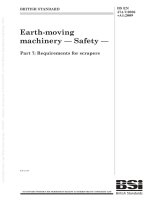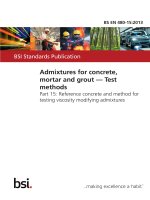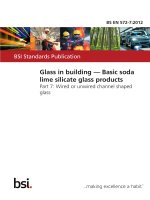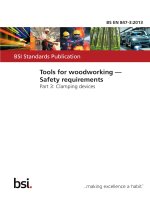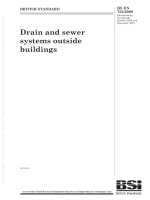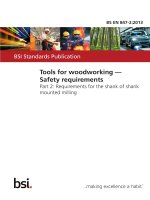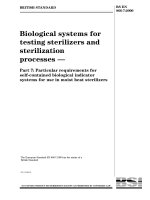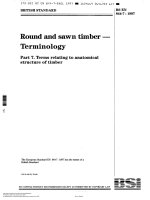Bsi bs en 61207 7 2013
Bạn đang xem bản rút gọn của tài liệu. Xem và tải ngay bản đầy đủ của tài liệu tại đây (1.45 MB, 28 trang )
BS EN 61207-7:2013
Incorporating corrigendum June 2015
BSI Standards Publication
Expression of performance
of gas analyzers
Part 7: Tuneable semiconductor
laser gas analyzers
BRITISH STANDARD
BS EN 61207-7:2013
National foreword
This British Standard is the UK implementation of EN 61207-7:2013. It is
identical to IEC 61207-7:2013, incorporating corrigendum June 2015.
The UK participation in its preparation was entrusted by Technical Committee GEL/65, Measurement and control, to Subcommittee GEL/65/2,
Elements of systems.
A list of organizations represented on this subcommittee can be obtained on
request to its secretary.
This publication does not purport to include all the necessary provisions of
a contract. Users are responsible for its correct application.
© The British Standards Institution 2015.
Published by BSI Standards Limited 2015
ISBN 978 0 580 90946 7
ICS 19.040; 71.040.40
Compliance with a British Standard cannot confer immunity from
legal obligations.
This British Standard was published under the authority of the
Standards Policy and Strategy Committee on 31 January 2014.
Amendments/corrigenda issued since publication
Date
Text affected
31 July 2015
Implementation of IEC corrigendum June 2015.
Figure B.1 updated
EN 61207-7
EUROPEAN STANDARD
NORME EUROPÉENNE
EUROPÄISCHE NORM
December 2013
ICS 19.040; 71.040.40
English version
Expression of performance of gas analyzers Part 7: Tuneable semiconductor laser gas analyzers
(IEC 61207-7:2013)
Expression des performances
des analyseurs de gaz Partie 7: Analyseurs de gaz laser à semiconducteurs accordables
(CEI 61207-7:2013)
Angabe zum Betriebsverhalten
von Gasanalysatoren Teil 7: Gasanalysatoren mit abstimmbaren
Halbleiterlasern
(IEC 61207-7:2013)
This European Standard was approved by CENELEC on 2013-10-30. CENELEC members are bound to comply
with the CEN/CENELEC Internal Regulations which stipulate the conditions for giving this European Standard
the status of a national standard without any alteration.
Up-to-date lists and bibliographical references concerning such national standards may be obtained on
application to the CEN-CENELEC Management Centre or to any CENELEC member.
This European Standard exists in three official versions (English, French, German). A version in any other
language made by translation under the responsibility of a CENELEC member into its own language and notified
to the CEN-CENELEC Management Centre has the same status as the official versions.
CENELEC members are the national electrotechnical committees of Austria, Belgium, Bulgaria, Croatia, Cyprus,
the Czech Republic, Denmark, Estonia, Finland, Former Yugoslav Republic of Macedonia, France, Germany,
Greece, Hungary, Iceland, Ireland, Italy, Latvia, Lithuania, Luxembourg, Malta, the Netherlands, Norway, Poland,
Portugal, Romania, Slovakia, Slovenia, Spain, Sweden, Switzerland, Turkey and the United Kingdom.
CENELEC
European Committee for Electrotechnical Standardization
Comité Européen de Normalisation Electrotechnique
Europäisches Komitee für Elektrotechnische Normung
CEN-CENELEC Management Centre: Avenue Marnix 17, B - 1000 Brussels
© 2013 CENELEC -
All rights of exploitation in any form and by any means reserved worldwide for CENELEC members.
Ref. No. EN 61207-7:2013 E
BS EN 61207-7:2013
EN 61207-7:2013
-2-
Foreword
The text of document 65B/876/FDIS, future edition 1 of IEC 61207-7, prepared by SC 65B
"Measurement and control devices” of IEC/TC 65 “Industrial-process measurement, control and
automation" was submitted to the IEC-CENELEC parallel vote and approved by CENELEC as
EN 61207-7:2013.
The following dates are fixed:
•
latest date by which the document has to be
implemented at national level by
publication of an identical national
standard or by endorsement
(dop)
2014-07-30
•
latest date by which the national
standards conflicting with the
document have to be withdrawn
(dow)
2016-10-30
This Standard is to be used in conjunction with EN 61207-1:2010.
Attention is drawn to the possibility that some of the elements of this document may be the subject of
patent rights. CENELEC [and/or CEN] shall not be held responsible for identifying any or all such
patent rights.
Endorsement notice
The text of the International Standard IEC 61207-7:2013 was approved by CENELEC as a European
Standard without any modification.
In the official version, for Bibliography, the following note has to be added for the standard indicated:
ISO 9001
NOTE
Harmonized as EN ISO 9001.
BS EN 61207-7:2013
EN 61207-7:2013
-3-
Annex ZA
(normative)
Normative references to international publications
with their corresponding European publications
The following documents, in whole or in part, are normatively referenced in this document and are
indispensable for its application. For dated references, only the edition cited applies. For undated
references, the latest edition of the referenced document (including any amendments) applies.
NOTE When an international publication has been modified by common modifications, indicated by (mod), the relevant EN/HD
applies.
Publication
Year
Title
EN/HD
Year
IEC 60654-1
1993
Industrial-process measurement
and control equipment - Operating
conditions Part 1: Climatic conditions
EN 60654-1
1993
IEC 60654-2
+ A1
1979
1992
Operating conditions for industrial-process
measurement and control equipment Part 2: Power
EN 60654-2
IEC 60654-3
1983
Operating conditions for industrial-process
measurement and control equipment Part 3: Mechanical influences
EN 60654-3
1997
IEC 60825-1
2007
Safety of laser products Part 1: Equipment classification and
requirements
EN 60825-1
2007
IEC 61207-1
2010
Expression of performance
of gas analyzers Part 1: General
EN 61207-1
2010
1)
EN 60654-2 includes A1 to IEC 60654-2.
1)
1997
BS EN 61207-7:2013
–2–
61207-7 IEC:2013
CONTENTS
INTRODUCTION ..................................................................................................................... 5
1
Scope ............................................................................................................................... 6
2
Normative references ....................................................................................................... 6
3
Terms and definitions ....................................................................................................... 7
4
Procedure for specification ............................................................................................. 10
4.1
4.2
5
General ................................................................................................................. 10
In situ analyzers .................................................................................................... 10
4.2.1 Additional operation and maintenance requirements .................................. 10
4.2.2 Additional terms related to the specification of performance ...................... 10
4.2.3 Additional limits of uncertainties ................................................................ 11
4.3 Extractive analyzers .............................................................................................. 11
4.3.1 Additional operation and maintenance requirements .................................. 11
4.3.2 Additional terms related to the specification of performance ...................... 12
4.4 Recommended standard values and range of influence quantities ......................... 12
4.5 Laser safety .......................................................................................................... 12
Procedures for compliance testing .................................................................................. 12
5.1
In situ
5.1.1
5.1.2
5.1.3
5.1.4
analyzers .................................................................................................... 12
General ..................................................................................................... 12
Apparatus to simulate measurement condition ........................................... 13
Apparatus to generate test gas mixture ..................................................... 13
Apparatus to investigate the attenuation induced by opaque dust,
liquid droplets and other particles .............................................................. 13
5.1.5 Testing procedures .................................................................................... 14
5.2 Extractive analyzers .............................................................................................. 16
5.2.1 General ..................................................................................................... 16
5.2.2 Apparatus to generate test gas mixture ..................................................... 16
5.2.3 Testing procedures .................................................................................... 16
Annex A (informative) Systems of tuneable semiconductor laser gas analyzers ................... 18
Annex B (normative) Examples of the test apparatus ........................................................... 19
Bibliography .......................................................................................................................... 23
Figure A.1 – Tuneable semiconductor laser gas analyzers .................................................... 18
Figure B.1 – Example of a test apparatus to simulate measurement condition for
across-duct and open-path analyzers .................................................................................... 19
Figure B.2 – Example of a test apparatus to simulate measurement condition for probe
type analyzers ...................................................................................................................... 19
Figure B.3 – Example of apparatus to generate the test gas mixture ..................................... 20
Figure B.4 – Delay time, rise time and fall time ..................................................................... 21
Figure B.5 – Example of a grid to simulate the attenuation by the dust in optical path ........... 22
BS EN 61207-7:2013
61207-7 IEC:2013
–5–
INTRODUCTION
This part of IEC 61207 includes the terminology, definitions, statements and tests that are
specific to tuneable semiconductor laser gas analyzers, which utilize tuneable semiconductor
laser absorption spectroscopy (TSLAS).
Tuneable semiconductor laser gas analyzers utilize tuneable semiconductor lasers (e.g. diode
lasers, quantum cascade lasers, interband cascade lasers) as light sources, whose
wavelength covers ultraviolet, visible and infrared part of the electromagnetic spectrum, to
detect the absorption spectra and thus determine the concentration of gases to be analyzed.
These analyzers may employ different TSLAS techniques such as direct absorption
spectroscopy, frequency modulation spectroscopy (FMS), wavelength modulation
spectroscopy (WMS), etc. Multi-pass absorption spectroscopy, photoacoustic spectroscopy
(PAS), and cavity-enhanced absorption spectroscopy (CEAS) such as cavity-ringdown
spectroscopy (CRDS) are also used to take advantage of their high detection sensitivity.
Tuneable semiconductor laser gas analyzers are usually used to measure concentration of
small molecule gases, such as oxygen, carbon monoxide, carbon dioxide, hydrogen sulfide,
ammonia, hydrogen fluoride, hydrogen chloride, nitrogen dioxide, water vapour etc.
There are two main types of tuneable semiconductor laser gas analyzers: extractive and in
situ analyzers. The extractive analyzers measure the sample gas withdrawn from a process or
air by a sample handling system. The in situ analyzers measure the gas in its original place,
including across-duct, probe and open-path types. Across-duct analyzers either have a laser
source and a detector mounted on opposite sides of a duct, or both the laser and the detector
are mounted on the same side and a retroreflector on the opposite side of a duct. Probe
analyzers comprise a probe mounted into the duct, and the measured gas either passes
through or diffuses into the measuring optical path inside the probe. And open-path analyzers
measure the gas in an open environment with a hardware approach similar to across duct
analyzers (source and detector on opposite sides of the open area or a retroreflector on one
side and the source and detector on the opposite side), except the sample is in an open path
and not contained in a duct.
NOTE 1 Traditionally, only diode lasers were employed, and thus tuneable diode laser gas analyzers and
tuneable diode laser absorption spectroscopy (TDLAS) are widely used terms. However, with the development of
laser technology, many other types of semiconductor lasers, such as quantum cascade lasers (QCLs) and
interband cascade lasers (ICLs) have been developed and employed in laser gas analyzers. Therefore, the term of
semiconductor laser rather than diode laser is used in this standard to reflect this technology advancement.
NOTE 2 Though tuneable semiconductor laser photoacoustic spectroscopy (PAS) is in principle different from
absorption spectroscopy typically used in tuneable semiconductor laser gas analyzers, the hardware and data
reduction software are almost the same for analyzers utilizing these two spectroscopy technologies, and thus PAS
is considered a variant of absorption spectroscopy and this standard also applies to the analyzers based on PAS.
BS EN 61207-7:2013
–6–
61207-7 IEC:2013
EXPRESSION OF PERFORMANCE OF GAS ANALYZERS –
Part 7: Tuneable semiconductor laser gas analyzers
1
Scope
This part of IEC 61207 applies to all aspects of analyzers utilizing TSLAS for the
concentration measurement of one or more gas components in a gaseous mixture or vapour.
It applies to analyzers utilizing tuneable semiconductor lasers as sources and utilizing
absorption spectroscopy, such as direct absorption, FMS, WMS, multi-pass absorption
spectroscopy, CRDS, ICOS, PAS and CEAS techniques, etc.
It applies both to in situ or extractive type analyzers. This standard includes the following, it
–
specifies the terms and definitions related to the functional performance of gas analyzers,
utilizing tuneable semiconductor laser gas absorption spectroscopy, for the continuous
measurement of gas or vapour concentration in a source gas,
–
unifies methods used in making and verifying statements on the functional performance of
this type of analyzers,
–
specifies the type of tests to be performed to determine the functional performance and
how to carry out these tests,
–
provides basic documents to support the application of the standards of quality assurance
with in ISO 9001
2
Normative references
The following documents, in whole or in part, are normatively referenced in this document and
are indispensable for its application. For dated references, only the edition cited applies. For
undated references, the latest edition of the referenced document (including any
amendments) applies.
IEC 60654-1:1993, Industrial-process measurement and control equipment – Operating
conditions – Part 1: Climatic conditions
IEC 60654-2:1979, Operating conditions for industrial-process measurement and control
equipment – Part 2: Power
Amendment 1:1992
IEC 60654-3:1983, Operating conditions for industrial-process measurement and control
equipment – Part 3: Mechanical influences
IEC 60825-1:2007,
requirements
Safety of laser products – Part 1: Equipment classification and
IEC 61207-1:2010,
Expression of performance of gas analyzers – Part 1: General
BS EN 61207-7:2013
61207-7 IEC:2013
3
–7–
Terms and definitions
For the purposes of this document, the following terms and definitions apply.
3.1
semiconductor laser
solid-state laser, in which the semiconductor material is used as active media
3.2
diode laser
semiconductor laser which is formed from a p-n junction and powered by injected electric
current
3.3
quantum cascade laser
semiconductor laser whose laser emission is achieved through the use of intersubband
transitions in a repeated stack of semiconductor multiple quantum structure, and typically
emits in the mid- to far-infrared portion of the electromagnetic spectrum
3.4
interband cascade laser
semiconductor laser whose laser emission is achieved through the use of interband
transitions between electrons and holes in a repeated stack of semiconductor multiple
quantum structure, but, instead of losing an electron to the valence band, the valence electron
can tunnel into the conduction band of the next quantum structure, and this process can be
repeated throughout the multiple quantum structure
3.5
extractive analyzer
analyzer which receives and analyzes a continuous stream of gas withdrawn from a process
by a sample handling system
3.6
in situ analyzer
analyzer which measures the gas in its original place, including across-duct, probe and openpath types
3.7
tuneable semiconductor laser absorption spectroscopy
TSLAS
spectroscopy which utilizes a tuneable semiconductor laser as radiation source, tunes the
emission wavelength of the laser over the characteristic absorption lines of measured species
in the laser beam path, detects the reduction of the measured signal intensity, and then
determines the gas concentration
3.8
tuneable semiconductor laser gas analyzer
gas analyzer which utilizes TSLAS to measure the concentration of one or more gas
components in a gaseous mixture or vapour
3.9
wavelength modulation spectroscopy
laser gas absorption spectroscopy, in which the wavelength of the laser beam is continuously
modulated across the absorption line and the signal is detected at a harmonic of the
modulation frequency
Note 1 to entry: Wavelength modulation spectroscopy utilizes a modulation frequency which is less than the halfwidth frequency of the transition lineshape.
BS EN 61207-7:2013
–8–
61207-7 IEC:2013
3.10
frequency modulation spectroscopy
spectroscopy that uses a modulation frequency larger than the half-width frequency of the
transition lineshape which results in a pair of sidebands separated from the carrier by the
modulation frequency
Note 1 to entry: An alteration of any of the sidebands by absorption causes an unbalance and therefore a net
signal which can be detected by a high speed photodetector.
3.11
cavity enhanced absorption spectroscopy
spectroscopy which utilizes the resonance of laser beam in high-finesse optical cavity to
prolong the effective path lengths
3.12
photoacoustic spectroscopy
spectroscopy which is based on the photoacoustic effect
Note 1 to entry: The acoustic effect is the energy from the laser beam transformed into kinetic energy of the
absorbing gas molecules. This results in local heating and thus a pressure wave or sound. By measuring the sound
intensity, the gas concentration can be determined.
3.13
multi-pass absorption spectroscopy
absorption spectroscopy utilizing a multi-pass gas cell, in which the reflected laser beam
passes through the gas multi-times to increase optical path length
3.14
transmittance
ratio of incident light energy transmitted to the total light energy incident on a given sample
3.15
transmittance influence uncertainty
maximum difference between the indicated values of gas concentration when transmittance
assumes any value larger than the rated minimum transmittance, while all other values are at
reference conditions
EXAMPLE Transmittance is reduced by dust, liquid droplets, and other particles in the measured gas and the
pollution of optical windows.
3.16
purge
method using zero gas to blow parts of the analyzer during measurement or calibration to
prevent the optical components from staining or being coated, and to implement positive
pressure explosion protection, or to avoid interference from gases outside measured path
3.17
purged optical path length
length of optical path filled with purge gas
3.18
gas temperature
temperature of measured gases
EXAMPLE Temperature of gas in the duct for across-duct analyzers, temperature of gas in the probe cavity for
probe analyzers, ambient gas temperature in the open environment for open-path analyzers, gas temperature in
the gas cell for extractive analyzers.
BS EN 61207-7:2013
61207-7 IEC:2013
–9–
3.19
gas pressure
pressure of measured gases
EXAMPLE The pressure in duct for across-duct and probe analyzers, ambient pressure of the open environment
for open-path analyzers, and the pressure in gas cell for extractive analyzers.
3.20
gas temperature influence uncertainty
maximum difference between the indicated values of gas concentration when the temperature
assumes any value within the rated range of gas temperature, all others being at reference
conditions
3.21
gas temperature influence uncertainty for calibration
maximum difference between the indicated values of gas concentration when the temperature
assumes any value within the rated range of calibration gas temperature, all others being at
reference conditions
3.22
gas pressure influence uncertainty
maximum difference between the indicated values of gas concentration when the pressure
assumes any value within the rated range of gas pressure, all others being at reference
conditions
3.23
gas pressure influence uncertainty for calibration
maximum difference between the indicated values of gas concentration when the pressure
assumes any value within the rated range of calibration gas pressure, all others being at
reference conditions
3.24
laser safety
safety design for use and implementation of lasers to minimise the risk of laser accidents,
especially those involving eye injuries
3.25
optical interference noise
interference fringes generated through multiple beam interferences between optical surfaces
within the coherent light source and the detector
Note 1 to entry: Interference fringes cause oscillation of the photocurrent during wavelength scanning. This
oscillation results in noise added to the absorption signal.
3.26
interfering components
components which interfere with the measurement of target species
Note 1 to entry: These interfering components include not only optically absorbing species by the fact that the
absorbance spectrum overlaps to the target species, but also non-optically absorbing species by line broadening of
the target species. (this can make stating/determining the measurement accuracy difficult).
Note 2 to entry: Namely, shape of optical absorbance spectrum of target species to be measured can be changed
itself significantly by change of background gas composition.
BS EN 61207-7:2013
– 10 –
4
61207-7 IEC:2013
Procedure for specification
4.1
General
The procedures for specification are detailed in IEC 61207-1. This covers:
–
operation and storage requirements;
–
specification of ranges of measurement and output signals;
–
limits of uncertainties;
–
recommended reference values and rated ranges of influence quantities (see IEC 60654-1,
IEC 60654-2, IEC 60654-3).
In this standard, additional operation and service requirements are given. Additional terms for
specification of performance and important aspects of performance relevant to tuneable
semiconductor laser gas analyzers are also detailed.
4.2
In situ analyzers
4.2.1
4.2.1.1
Additional operation and maintenance requirements
Facilities and requirements for purge
The quality of purge gas such as dust and oil load, concentration limit of measured gas
component in the purge gas, and rated range of purge gas pressure and flow rate shall be
stated.
4.2.1.2
Facilities and methods for calibration or electronic and optical integrity
checking
The rated range of temperature, pressure and flow rate of calibration gas shall be stated.
The gas components and their corresponding concentration levels in calibration gas shall be
stated.
Facilities and procedures for optical aligning shall be stated.
4.2.1.3
Facilities and requirements for automatic compensation for gas temperature
or pressure variations
Specifications of required temperature or pressure sensors shall be stated.
4.2.1.4
Facilities and requirements for essential maintenance
Maintenance methods, facilities and the time intervals for maintenance shall be stated.
4.2.2
Additional terms related to the specification of performance
4.2.2.1 Rated minimum transmittance, above which the measurement uncertainty of the
analyzers is below the specified uncertainty limit, shall be stated.
4.2.2.2 Rated range of optical path length, which is required to ensure sufficient gas
absorption and transmittance.
4.2.2.3 Rated range of gas temperature, within which the measurement uncertainty of the
analyzers is below the specified uncertainty limit, shall be stated.
BS EN 61207-7:2013
61207-7 IEC:2013
– 11 –
4.2.2.4 Rated range of gas pressure, within which the measurement uncertainty of the
analyzers is below the specified uncertainty limit, shall be stated.
4.2.2.5 Rated range of calibration gas temperature, within which the uncertainty of
calibration is below the specified uncertainty limit, shall be stated.
4.2.2.6 Rated range of calibration gas pressure, within which the uncertainty of calibration is
below the specified uncertainty limit, shall be stated.
4.2.2.7 Rated range of gas flow rate, within which the measurement uncertainty of the
analyzers is below the specified uncertainty limit, shall be stated.
4.2.2.8 Rated range of interfering components, within which the measurement uncertainty of
the analyzers is below the specified uncertainty limit, shall be stated.
NOTE The interfering components can normally include water vapour, carbon dioxide, nitric oxide, oxygen,
hydrogen chloride, carbon monoxide, etc.
4.2.2.9 Rated range of operating ambient temperature, within which the measurement
uncertainty of the analyzers is below the specified uncertainty limit, shall be stated.
4.2.2.10 Rated range of operating ambient pressure, within which the measurement
uncertainty of the analyzers is below the specified uncertainty limit, shall be stated.
4.2.3
Additional limits of uncertainties
4.2.3.1
Gas temperature influence uncertainty.
4.2.3.2
Gas temperature influence uncertainty for calibration.
4.2.3.3
Gas pressure influence uncertainty.
4.2.3.4
Gas pressure influence uncertainty for calibration.
4.2.3.5
Transmittance influence uncertainty.
4.3
Extractive analyzers
4.3.1
4.3.1.1
Additional operation and maintenance requirements
Facilities and requirements for purge
The quality of purge gas such as dust and oil load, concentration limit of measured gas
component in the purge gas, and rated range of purge gas pressure and flow rate shall be
stated.
4.3.1.2
Facilities and methods for calibration or electronic and optical integrity
checking
The rated range of temperature, pressure and flow rate of calibration gas shall be stated.
The gas components and their corresponding concentration levels in calibration gas shall be
stated.
4.3.1.3
Facilities and requirements for essential maintenance
Maintenance methods, facilities and the time intervals for maintenance shall be stated.
BS EN 61207-7:2013
– 12 –
4.3.2
61207-7 IEC:2013
Additional terms related to the specification of performance
4.3.2.1 Rated minimum transmittance, above which the measurement uncertainty of the
analyzers is below the specified uncertainty limit, shall be stated.
4.3.2.2 Rated range of gas temperature, within which the measurement uncertainty of the
analyzers is below the specified uncertainty limit, shall be stated.
4.3.2.3 Rated range of gas pressure, within which the measurement uncertainty of the
analyzers is below the specified uncertainty limit, shall be stated.
4.3.2.4 Rated range of calibration gas temperature, within which the uncertainty of
calibration is below the specified uncertainty limit, shall be stated.
4.3.2.5 Rated range of calibration gas pressure, within which the uncertainty of calibration is
below the specified uncertainty limit, shall be stated.
4.3.2.6 Rated range of gas flow rate, within which the measurement uncertainty of the
analyzers is below the specified uncertainty limit, shall be stated.
4.3.2.7 Rated range of interfering components, within which the measurement uncertainty of
the analyzers is below the specified uncertainty limit, shall be stated.
NOTE The interfering components normally include water vapour, carbon dioxide, nitric oxide, oxygen, hydrogen
chloride, carbon monoxide, etc.
4.3.2.8 Rated range of operating ambient temperature, within which the measurement
uncertainty of the analyzers is below the specified uncertainty limit, shall be stated.
4.3.2.9 Rated range of operating ambient pressure, within which the measurement
uncertainty of the analyzers is below the specified uncertainty limit, shall be stated.
4.4
Recommended standard values and range of influence quantities
The rated ranges and use of influence quantities for climatic conditions, mechanical
conditions and main supply conditions shall be in accordance with those defined in
IEC 60654-1, IEC 60654-2, IEC 60654-3.
4.5
Laser safety
The laser classification of light source of analyzer shall be in accordance with those defined in
IEC 60825-1.
5
Procedures for compliance testing
5.1
5.1.1
In situ analyzers
General
For the verification of values specifying the performance see IEC 61207-1, together with the
following.
The tests considered in 5.1 apply to the complete analyzer as supplied by the manufacturer.
The analyzer will be set up in accordance with the instruction delivered by the manufacturer.
BS EN 61207-7:2013
61207-7 IEC:2013
5.1.2
– 13 –
Apparatus to simulate measurement condition
The test apparatus for in situ analyzers (see Figure B.1) shall include mechanical components
required to present test gases to the measurement path at the appropriate temperature and
pressure. For across-duct or open-path analyzers an optical cell is required with transparent
wedged windows to minimise optical interference noise. This optical cell should be placed in
the uniform temperature region of furnace, and purge tubes are arranged between the
analyzer and the optical cell to avoid interference from air. For delay, rise and fall time
measurements, another gas cell filled with either zero or span gas is required. Purge tubes
and both cells should be of sufficient diameter to accommodate the analyzer beam width. For
probe type analyzers, the test apparatus may have a sealed end-cap for the probe, with
appropriate gas connections installed. This entire apparatus is then placed within a furnace
(see Figure B.2).
To simulate the measurement conditions, it is required that gas absorbance in test conditions
is comparable to that in measurement conditions. For example, when the pressure and
temperature are the same for measurement and test conditions, the cell length and the gas
concentration to be measured can be selected as follows:
X a L a =X t L t
where
Xa
is the maximum gas concentration in the measurement condition;
La
is the optical path length in the measurement condition;
Xt
is the gas concentration in gas cell;
Lt
is the length of the optical cell.
5.1.3
Apparatus to generate test gas mixture
Test gas mixture can either use standard gas or gas generated by a test gas generator, which
requires at least two gas flow controllers to adjust the flow rates of standard and dilution
gases (see Figure B.3). The standard and dilution gases are mixed in a gas mixing device to
obtain uniform gas mixture. The concentration of the test component in the gas mixture can
be calculated as follows:
X t =X s R s /(R s + R d )
where
Xs
is the concentration of the test component in the standard gas;
Rs
is the flow rate of standard gas;
Xt
is the concentration of the test component in the gas mixture;
Rd
is the flow rate of dilution gas.
5.1.4
Apparatus to investigate the attenuation induced by opaque dust, liquid
droplets and other particles
Test equipment for in situ analyzers shall include an apparatus to investigate the attenuation
induced by dust, liquid droplets and other particles in optical path. Such an apparatus can be
a set of neutral density filters or grids with different transmittance to simulate the attenuation
induced by opaque dust, liquid droplets and other particles; each grid has square mesh holes
as illustrated in Figure B.5.
BS EN 61207-7:2013
– 14 –
5.1.5
61207-7 IEC:2013
Testing procedures
5.1.5.1
General
The following relevant testing procedures are detailed in IEC 61207-1:
–
intrinsic uncertainty;
–
linearity uncertainty;
–
repeatability;
–
output fluctuation;
–
warm-up time;
–
variations (influence uncertainties);
–
interference uncertainty.
Additional test details required for in situ tuneable semiconductor laser gas analyzers are
given below.
5.1.5.2
Drift
The test period should be chosen appropriately for the specific application from the following
values:
–
24 h;
–
7 days;
–
30 days;
–
3 months;
–
6 months;
–
1 year.
The readings may be corrected for temperature and pressure variations.
The test procedure detailed in 5.6.5 of IEC 61207-1:2010 is used except the following. Test
gas with appropriate stable concentration is applied to the analyzer until a stable indication is
given and at least 12 indicated values are recorded continuously, and then average value is
calculated. This procedure is carried out at the beginning and end of the specified test period,
and at a minimum of six, approximately evenly spread, time intervals within the test period.
The drift over the time period is the maximum difference of the calculated average values.
The readings of tuneable semiconductor laser gas analyzers may have periodical fluctuations
in hour scale, which is caused by optical interference noise and should be considered as part
of the drift. So the slope of linear regression of indicated values as specified in IEC 61207-1
cannot provide an accurate estimate of the drift.
5.1.5.3
Delay time, rise time and fall time
For across-duct and open-path analyzers, perform continuous measurement and wait until a
stable indication is given. Insert a gas cell filled with zero (span) gas into the light path (see
Figure B.1) and designate this moment as the start time of the step change for falling (rising)
delay time. When indicated values become stable, remove the gas cell from the light path and
designate this moment as the start time of the step change for rising (falling) delay time. The
measurement is continued until the indicated values become stable.
BS EN 61207-7:2013
61207-7 IEC:2013
– 15 –
The values for delay time, rise time and fall time as defined in 3.5.13, 3.5.14 and 3.5.15 of
IEC 61207-1:2010 are determined from the recorded data, in conjunction with logged time
intervals (see Figure B.4).
The time interval of gas cell replacement shall be much shorter than the rise (fall) time of
analyzers.
NOTE The procedure for extractive (5.6.6 of IEC 61207-1:2010) analyzers is also applicable for in situ analyzers
as long as the gas exchange time is negligible against the response times of the analyzer.
5.1.5.4
Transmittance influence uncertainty
The analyzer is presented with a continued flow of test gas mixture giving a full scale or near
full scale indication. The indicated value is recorded until any change in reading is less than
or equal to the intrinsic uncertainty of the analyzer. Then sequentially insert the neutral
density filters or grids with rated minimum transmittance and at least three neutral density
filters or grids whose transmittances approximately evenly spread within the rated range of
transmittance into the optical path of analyzer (see Figure B.1), and the indicated values are
recorded correspondingly. This procedure shall be repeated at least three times, and the
averages of indicated reading for each test transmittance are calculated. The transmittance
influence uncertainty is the maximum difference of the calculated average values.
5.1.5.5
Gas temperature influence uncertainty
Control the temperature of the test gas to upper and lower limits of rated range of gas
temperature, and to a minimum of three, approximately evenly spread, temperatures within
the rated range of gas temperature, and control the pressure of the test gas to the middle of
rated range of gas pressure. The indicated values at each temperature are recorded. This
procedure is carried out at least three times and the averages of indicated values for each
test temperature are calculated. The gas temperature influence uncertainty is the maximum
difference of the calculated average values.
5.1.5.6
Gas temperature influence uncertainty for calibration
Control the temperature of the test gas to upper and lower limits of rated range of calibration
gas temperature, and to a minimum of three, approximately evenly spread, temperatures
within the rated range of calibration gas temperature, and control the pressure of test gas to
the middle of rated range of calibration gas pressure. The indicated values at each
temperature are recorded. This procedure is carried out at least three times and the averages
of indicated values for each test temperature are calculated. The gas temperature influence
uncertainty for calibration is the maximum difference of the calculated average values.
5.1.5.7
Gas pressure influence uncertainty
Control the pressure of the test gas to upper and lower limits of rated range of gas pressure,
and to a minimum of three, approximately evenly spread, pressures within the rated range of
gas pressure, and control the temperature of test gas to the middle of rated range of gas
temperature. The indicated values at each pressure are recorded. This procedure is carried
out at least three times and the averages of indicated values for each test pressure are
calculated. The gas pressure influence uncertainty is the maximum difference of the
calculated average values.
5.1.5.8
Gas pressure influence uncertainty for calibration
Control the pressure of the test gas to upper and lower limits of rated range of calibration gas
pressure, and to a minimum of three, approximately evenly spread, pressures within the rated
range of calibration gas pressure, and control the temperature of test gas to the middle of
rated range of calibration gas temperature. The indicated values at each pressure are
recorded. This procedure is carried out at least three times and the averages of indicated
reading for each pressure are calculated. The gas pressure influence uncertainty for
calibration is the maximum difference of the calculated average values.
BS EN 61207-7:2013
– 16 –
5.2
61207-7 IEC:2013
Extractive analyzers
5.2.1
General
For the verification of values specifying the performance, see IEC 61207-1, together with the
following.
The tests considered in 5.2 apply to the complete analyzer as supplied by the manufacturer.
The analyzer will be set up in accordance with the instruction delivered by the manufacturer.
5.2.2
Apparatus to generate test gas mixture
Test gas mixture can either use standard gas or gas generated by a test gas generator, which
requires at least two gas flow controllers to adjust the flow rates of standard and dilution
gases (see Figure B.3). The standard and dilution gases are mixed in a gas mixing device to
obtain uniform gas mixture. The concentration of the test component in the gas mixture can
be calculated as follows:
X t =X s R s /(R s + R d )
where
Xs
is the concentration of the test component in the standard gas;
Rs
is the flow rate of standard gas;
Xt
is the concentration of the test component in the gas mixture;
Rd
is the flow rate of dilution gas.
5.2.3
5.2.3.1
Testing procedures
General
The following relevant testing procedures are detailed in IEC 61207-1:
–
intrinsic uncertainty;
–
linearity uncertainty;
–
repeatability;
–
output fluctuation;
–
delay time, rise time and fall time;
–
warm-up time;
–
variations (influence uncertainties);
–
interference uncertainty.
Additional test details required for extractive tuneable semiconductor laser gas analyzers are
given below.
BS EN 61207-7:2013
61207-7 IEC:2013
5.2.3.2
– 17 –
Drift
The test period should be chosen appropriately for the specific application from the following
values:
–
24 h;
–
7 days;
–
30 days;
–
3 months;
–
6 months;
–
1 year.
The readings may be corrected for temperature and pressure variations.
The test procedure detailed in 5.6.5 of IEC 61207-1:2010 is used except the following. Test
gas with appropriate stable concentration is applied to the analyzer until a stable indication is
given and at least 12 indicated values are recorded continuously, and then average value is
calculated. This procedure is carried out at the beginning and end of the specified test period,
and at a minimum of six, approximately evenly spread, time intervals within the test period.
The drift over the time period is the maximum difference of the calculated average values.
The readings of tuneable semiconductor laser gas analyzers may have periodical fluctuations
in hour scale, which is caused by optical interference noise and is considered as part of the
drift. So the slope of linear regression of indicated values, as specified in IEC 61207-1, cannot
provide an accurate estimate of the drift.
BS EN 61207-7:2013
– 18 –
61207-7 IEC:2013
Annex A
(informative)
Systems of tuneable semiconductor laser gas analyzers
Annex A depicts the variety of tuneable laser gas analyzer systems covered by this document.
Tuneable semiconductor
laser gas analyzer
Extractive
analyzers
Across-duct
analyzers
In situ
analyzers
Open-path
analyzers
Probe
analyzers
IEC 2419/13
Figure A.1 – Tuneable semiconductor laser gas analyzers
BS EN 61207-7:2013
61207-7 IEC:2013
– 19 –
Annex B
(normative)
Examples of the test apparatus
Annex B depicts examples of a variety of tuneable laser gas analyzer test apparatus and
techniques.
Uniform temperature region
Vent
Temperature controlled furnace
Purge gas inlet
Purge tube
Purge gas inlet
Valve
Optical unit on
mounting frame
Apparatus to simulate
attenuation by dust
Optical unit on
mounting frame
Purge tube
Valve
Gas cell for time
measurement
Pressure sensor
Transparent windows with
wedge (about 0,7°) and
form angle (about 7°) with
axis of optical cell
Temperature sensor
IEC 2420/13
Test gas generator
Figure B.1 – Example of a test apparatus to simulate
measurement condition for across-duct and open-path analyzers
Vent
Temperature controlled furnace
Valve
Mineral wool
Probe
Temperature sensor
Pressure sensor
Valve
O-ring or flanged fitting,
as appropriate
Test gas generator
Figure B.2 – Example of a test apparatus to simulate
measurement condition for probe type analyzers
IEC 2421/13
BS EN 61207-7:2013
– 20 –
61207-7 IEC:2013
Flow rate controller
Gas mixing device
.
.
.
To analyzer
IEC 2422/13
Figure B.3 – Example of apparatus to generate the test gas mixture
BS EN 61207-7:2013
61207-7 IEC:2013
– 21 –
Remove span gas cell
T90
Insert span gas cell
T10
100 %
Tr
10 %
90 %
Step
change
Step
change
90 %
10 %
100 %
Tr
T10
IEC 2423/13
T90
Insert zero gas cell
T90
T10
10 %
Tr
Remove zero gas cell
100 %
90 %
Step
change
Step
change
90 %
100 %
10 %
T10
Tr
T90
IEC 2424/13
Figure B.4 – Delay time, rise time and fall time
BS EN 61207-7:2013
– 22 –
61207-7 IEC:2013
N bands
A
B
IEC 2425/13
Figure B.5 – Example of a grid to simulate the attenuation by the dust in optical path
BS EN 61207-7:2013
61207-7 IEC:2013
– 23 –
Bibliography
ISO 9001,
Quality management systems – Requirements
____________
